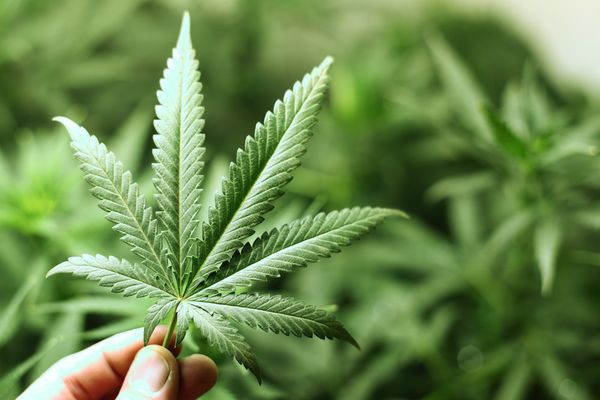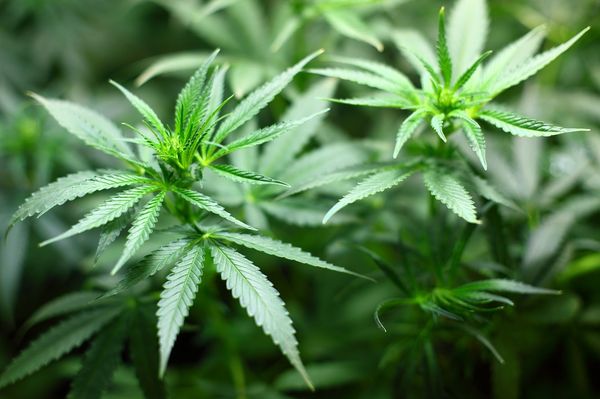- Every day more and more scientific research indicates that cannabis can be effective in helping to treat various health problems.
- This plant's natural interaction with our endocannabinoid system means that it often can complement and, on some occasions, even replace traditional medicines, in addition to reinforcing therapies to provide patients with a better quality of life.

The scientific evidence has also prompted many countries to re-examine their prohibitionist policies on cannabis, considering the medical, social and economic benefits it can give citizens. To give one an idea of its true dimensions, these are just ten examples of diseases that, according to studies, respond well to marijuana-based treatments:
1- Cannabis can trigger the self-destruction of cancer cells
This constitutes one of the greatest discoveries made, given the major social impact of this disease. There are many scientists who are currently studying cannabis's capacities as a cancer therapy, and one of the pioneers is a team at the Universidad Complutense de Madrid that has spent ten years using cannabinoids to treat certain types of tumours. Led by Professor Guillermo Velasco, they are centring their efforts on analysing the efficacy of these organic compounds.
They team has found that cannabinoids have an "anti-tumour" effect that functions in three ways: firstly, they induce the death of tumorous cells because they operate on them, aggressively activating their metabolism. Secondly, they block the generation of blood vessels that make it possible for nutrients to pass between cancer cells, thereby preventing the tumour from growing. Thirdly, they decrease the ability of tumour cells to move and invade other tissues, in this way averting the metastasis process.
Implications:
The most important thing is that US authorities have already assigned credibility to these types of studies. The National Institute on Drug Abuse (NIDA) has recognised that marijuana has the ability to kill cancer cells; and a few months ago the website of the US National Cancer Institute was updated to recognise that cannabinoids help stop cancer by killing damaged cells in the body while protecting healthy ones. This change in the official information marks a major breakthrough and achievement for those who have long been fighting for visible recognition of cannabis's benefits in the fight against cancer.
2- Cannabis can help to treat Alzheimer's disease
Spanish professionals are, once again, pioneers in this field. Researcher Maria L. de Ceballos, at the Instituto Cajal of Spain's CSIC (Spanish National Research Council), has spent 14 years studying cannabinoids as a possible means of treatment for Alzheimer's disease. Her first study dates from 2005, when she demonstrated that cannabinoids have anti-inflammatory properties and can check the process that causes swelling and protects neurons (when a person has Alzheimer's, his brain swells and he suffers from "neuroinflammation").
In addition to its neuroprotective properties, using cannabinoids in the treatment of incipient Alzheimer's disease can help alleviate other problems that tend to occur. It has, for example, vascular properties, as they are vasodilating compounds that help to reduce hypertension and the cardiovascular alterations that patients often suffer.
Implications:
The latest research published in the Journal of Alzheimer's Disease (USA) even suggests that THC can reduce levels of a protein linked to symptoms, and could halt their onset. However, thus far it has only been tested in rats and mice, not on humans.
In order to carry out human trials clinical neurologists would need to get involved, but thus far they have not. And there's a bigger problem: the drug companies do not seem very interested – a big mistake given the magnitude of Alzheimer's as a health and social problem, in which very little is invested compared to, for example, cancer research.

3- CBD extract can reduce seizures in children with epilepsy
For the past couple of years we have been hearing about the experiences of children with epilepsy who note major improvements thanks to cannabis oil rich in CBD. The case of Charlotte Figi is the best known, because it helped to change medical marijuana laws in the United States. But it is not the only one where the data shows that cannabidiol can be an important tool to treat different types of epilepsy.
In fact, Epidiolex is about to hit the market, a marijuana extract produced by the pharmaceutical company GW Pharmaceuticals (the same one that sells Sativex) and that contains cannabidiol. According to tests, 3 months after starting on this drug, the overall frequency of seizures was reduced, on average, by 45% amongst participants. Another 47% experienced a 50% reduction or more in seizures, and almost 10% suffered none at all. Those who suffered from Dravet's syndrome saw a 62% reduction in seizures, and 13% had none. In addition, those who suffered from Lennox-Gastaut syndrome enjoyed a 71% drop in seizures. Only 10% of those who participated in the study noted adverse effects, such as drowsiness, fatigue and diarrhoea, having to discontinue treatment.
Implications:
Thanks to this type of evidence, the American Academy of Pediatrics has taken a big step by accepting medical marijuana as an alternative treatment for children. The institution endorses every medical record being reviewed, and letting doctors decide whether patients really need cannabis to improve their health.
Children with epilepsy, for example, can suffer hundreds of seizures daily (more than 200 or 300 in cases of pathologies like Dravet Syndrome), preventing them from leading normal lives as children; smiling, talking, eating and moving. For many of these children cannabis is practically their only hope.
4- Medical cannabis can reduce opiate addiction
The US is currently suffering from an epidemic of addiction to painkillers, which are mostly opiate-based. These are very effective but highly addictive substances. Sales have quadrupled in recent years, and 2 million Americans are now addicted to these prescription drugs, while 16,000 people die each year from overdoses.
Numerous research efforts have demonstrated that medical cannabis is a safe and effective pain reliever that helps those who are dependent on opiates to "detoxify", as demonstrated by this study backed by Columbia University. Cannabis boasts a safer profile than most pain medications on the market, and the side effects associated with its use are typically mild (headaches, drowsiness and dry mouth). Opioid drugs are saddled with many more health risks and unpleasant side effects.
Implications:
At a time when this addiction is wreaking havoc in our society, we must find a more practical solution to manage pain. The good news is that the states where medical marijuana is now legal are reporting significantly lower rates of addiction to these drugs, and overdose deaths have fallen by an average of 25%. In Switzerland the state distributes small doses of cannabis to treat citizens hooked on heroin. And in Portugal, the number of overdoses has declined markedly since the decriminalisation of drugs in 2001.

5- Cannabis is able to slow the advance of Multiple Sclerosis
The question of whether marijuana should be used to treat this disease is complex, as there is uncertainty about its benefits in relation to its side effects. Multiple Sclerosis patients suffer from permanent muscle contraction, spasms, severe pain and difficulty sleeping. The drugs that have traditionally been prescribed to treat these symptoms are not effective, so many of them have chosen to use cannabis.
In 2012 a study conducted by the Cannabinoids Research Group at the Universidad Complutense de Madrid (UMC) revealed cannabis's positive effects in an MS model in mice, demonstrating improvements in halting the disease's progression. And there are more and more studies providing a scientific basis for the development of drugs that make possible therapies based on the modulation of the endocannabinoid system.
Implications:
These studies were the genesis of Sativex, an oral spray derived from cannabis (by GW Pharmaceuticals) which significantly improves spasticity in a percentage of Multiple Sclerosis patients who had been identified as likely to respond to therapy. When well tracked, clinical trials help resolve the contradictory conclusions about the use of marijuana to treat MS symptoms. Today Sativex is the most commonly used cannabis-based drug to treat spasticity, available in 15 countries and approved in another 12, including the United States.
6- Cannabis can alleviate chronic pain due to fibromyalgia
Fibromyalgia is a chronic pain syndrome of unknown origin, characterised by widespread musculoskeletal pain, fatigue and multiple sensitive points on the body. Some patients use cannabis therapeutically to treat their symptoms, but there are still few clinical trials to evaluate its effects.
What we do know is that Cannabis sativa possesses about 400 different chemical molecules, of which about 60 have analgesic properties. Some experts have suggested that cannabinoids can be used to treat chronic pain, such as that stemming from fibromyalgia, and have theorised that the disease may be traceable to an underlying clinical deficiency of the endocannabinoid system, which also plays an important role in migraines, irritable bowel syndrome, and a growing list of medical conditions.
Implications:
One of the most important studies was carried out the Instituto de Recerca del Hospital del Mar, in Barcelona, where they evaluated the benefits associated with cannabis consumption in fibromyalgia patients. Their conclusion was clear: "Patients who used cannabis not only saw their pain alleviated, and a reduction in almost all associated symptoms, but no one reported worsening after consumption."
In a recent online survey by the National Pain Foundation in the United States, in which more than 1,300 fibromyalgia patients participated, the results indicated that cannabis was the most effective treatment for symptoms, beating all the prescription medications on the market (Lyrica, Cymbalta and Savella). Even actor Morgan Freeman has acknowledged that that he uses medical cannabis to deal with the effects of a near-fatal car accident in 1997. Since then he has suffered from fibromyalgia in his left arm: "I have chronic pain and the only thing that relieves it is marijuana. "

7- Marijuana regulates blood sugar levels and could help prevent diabetes
Many preclinical studies have indicated that cannabinoids are inversely correlated with diabetes, as it can modify the disease's progression and also provide symptomatic relief to those who suffer from it. In a way it seems paradoxical, because cannabis consumption has always been associated with the need to consume sweets and treats. Nevertheless, the data actually indicates lower rates of obesity and diabetes among those who consume cannabis.
Researchers at Harvard Medical School evaluated the relationship between marijuana consumption and fasting insulin, glucose and insulin resistance, in a sample of 4,657 male subjects. They came to a conclusion: "Those subjects who reported using marijuana in the last month had lower levels of fasting insulin smaller waist circumferences, and higher levels of HDL-C (or "good cholesterol"). More recently, Canadian researchers evaluated cannabis consumption patterns and Body Mass Indexes (BMI) in a tribe of 786 Inuits (indigenous Arctic people), and got the same results.
Implications:
These findings illustrate a link between cannabis use and diabetic markers. Moreover, they are supported by previous population data showing that people who use cannabis are less likely to be obese than those who do not.
All this goes to show that marijuana helps control the effects of blood sugar. Apparently, this beneficial effect could be related to improved activity in the hormone adiponectin, which is responsible for modulating different metabolic processes, including the regulation of glucose.
8- Marijuana helps treat PTSD
It is estimated that one in ten Americans suffers from Post-Traumatic Stress Disorder, a mental condition caused by a traumatic event and whose symptoms can include flashbacks, nightmares and severe anxiety. The endocannabinoid system is believed to play a fundamental role in these types of disorders.
Researchers theorise that cannabis can curb the strength and emotional impact of traumatic memories, making it easier for patients to sleep and relax, feel less anxiety, and suffer fewer flashbacks. And mounting evidence suggests that cannabinoids could play an important role in suppressing fear, thanks to its anti-depressant effects.
Implications:
The therapeutic use of marijuana has been proven to very beneficial to treat recurrent symptoms and pathologies among veterans. However, the US's Department of Veterans Affairs, the agency responsible for protecting the rights of its more than 22 million veterans, had prohibited the prescription of these kinds of treatments until just one month ago. Post-Traumatic Stress Disorder (PTSD) in veterans of the wars in Afghanistan and Iraq has led to some 8,000 suicides per year; 22 people lose their lives daily for this reason, according to the Department's own appalling estimates.
9- Cannabis helps regulate bone mass, and could prevent osteoporosis
There are several studies concluding that cannabinoids stimulate bone formation, a discovery that seems to pave the way for the future use of marijuana in the fight against osteoporosis and other bone-related diseases.
The latest study with this finding was conducted by scientists at the University of Tel Aviv and published in the "Journal of Bone and Mineral Research". The study indicated that fractured femoral bones in the rats used for the experiment mended faster when they were administered cannabidiol, marijuana's non-psychoactive component. Treatment markedly improved the femur's healing process after eight weeks. Scientists found that CBD alone makes bones stronger during healing and improves the development of the collagen base, which provides the foundation for the new mineralisation of the bone tissue. "After being treated with CBD, the mended bone will be harder to break in the future," they concluded.
Implications:
One in three women and one in five men over age 50 will suffer some form of injury due to weak bones. It affects more than 3.5 million people in Spain alone, and yet, more than half of patients are unaware of it. Diagnosis continues to be poor, and treatment, often non-existent.
Now scientists speculate that the main physiological function of specific endocannabinoid receptors (CB2) is to maintain "bone reconstitution in balance, thereby protecting the skeleton against bone loss related to age," which has led some experts to believe that cannabinoids may be a promising field, full of potential for the development of anti-osteoporotic drugs in the future.

10- Cannabis may be useful in the treatment of neurodegenerative diseases, such as Parkinson's, Huntington's, and Tourette syndrome
Although neurodegenerative disorders tend to be associated with conditions like Parkinson's disease, there are actually hundreds of pathologies of this type for which there is normally no cure. How could cannabis help these patients diagnosed with a neurodegenerative disorder? Because cannabinoids have potent neuroprotective, anti-inflammatory and anti-oxidant properties. They also have the ability to alleviate the disease's motor-skill symptoms, thanks to their hypokinetic profile, which makes it possible to enhance movement capacities. They also relieve pain and improve patients' sleep.
In August 2015 the American Academy of Neurology published a review of trials that used cannabis for the treatment of neurological disorders. They found several cannabinoids that have exhibited "effectiveness" or "probable effectiveness" in the relief of spasms and central pain. They even went so far as to state that health insurance should pay for drugs based on synthetic cannabinoids (such as dronabinol and nabilone) for patients who could benefit from them.
Implications:
For patients and their families, these debilitating and incurable diseases can be devastating. And, given the long-term impact of their treatment, finding cost-effective solutions should be a priority. Despite this enormous progress, further research is necessary to reliably establish the role of the endocannabinoid system with regards to these diseases, and to evaluate the possible use of medical marijuana in the treatment of their symptoms. Cannabis could well become an additional therapy for patients who suffer side effects from current treatment options.



Comments from our readers
Read comments in other languages:
Did you like this post?
Your opinion about our seeds is very important to us and can help other users a lot (your email address won't be made public).